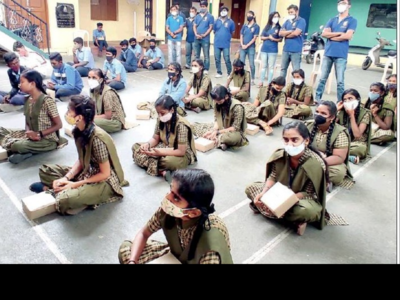- News
- City News
- mysuru News
- Karnataka: Only 34% of govt schools have working computer lab
Karnataka: Only 34% of govt schools have working computer lab

Citizens under Team Bengaluru Hudugaru gave immunity booster kits to SSLC students on Saturday
MYSURU: In the era of digital education, only 7.7 per cent of government schools in the state have internet access and just 34.3% have functional computer facilities. These are some of the findings in the 2019-20 report of the Unified District Information System for Education (UDISE+).
Though the survey was conducted before the pandemic, experts believe that it, more or less, reflects the current status of government schools. In contrast, 62.4 per cent of private unaided schools have internet and 68.4 per cent have working computer labs.
MS Thimmappa, a noted academic and former vicechancellor of the Bangalore University, said that the government must look into this digital divide seriously. “The government has funds; implementation is the only challenge. Our policymakers must look into these kinds of challenges. Schools lack an internet connection because of corruption or ignorance. We need to rectify this,” he said. He added that lack of facilities put students of government schools at a disadvantage compared to private school pupils.
According to the UDISE+ report, only 3,862 out of 49,834 government schools have internet access. Of the 20,069 private unaided schools, 12,530 have this facility. There are 7,244 government-aided private schools in the state, and 2,623 of these have net connections.
The report states that 17,130 government, 4,882 aided private and 13,739 private unaided schools have functional computer labs.
In Chamarajanagar district, which has a sizeable tribal population, only five government and 36 private unaided schools have a net connection. In Kodagu and Shivamogga districts, nine and 86 government schools have access, respectively.
Chandrashekar Nuggi, the general secretary of the Government Teachers’ Association, said that most students enrolled in government schools were from economically weaker and socially backward classes. “We are aware of the situation (lack of facilities). That is why we are opposing internet-based learning systems,” he added.
Though the survey was conducted before the pandemic, experts believe that it, more or less, reflects the current status of government schools. In contrast, 62.4 per cent of private unaided schools have internet and 68.4 per cent have working computer labs.
MS Thimmappa, a noted academic and former vicechancellor of the Bangalore University, said that the government must look into this digital divide seriously. “The government has funds; implementation is the only challenge. Our policymakers must look into these kinds of challenges. Schools lack an internet connection because of corruption or ignorance. We need to rectify this,” he said. He added that lack of facilities put students of government schools at a disadvantage compared to private school pupils.
According to the UDISE+ report, only 3,862 out of 49,834 government schools have internet access. Of the 20,069 private unaided schools, 12,530 have this facility. There are 7,244 government-aided private schools in the state, and 2,623 of these have net connections.
The report states that 17,130 government, 4,882 aided private and 13,739 private unaided schools have functional computer labs.
In Chamarajanagar district, which has a sizeable tribal population, only five government and 36 private unaided schools have a net connection. In Kodagu and Shivamogga districts, nine and 86 government schools have access, respectively.
Chandrashekar Nuggi, the general secretary of the Government Teachers’ Association, said that most students enrolled in government schools were from economically weaker and socially backward classes. “We are aware of the situation (lack of facilities). That is why we are opposing internet-based learning systems,” he added.
FacebookTwitterLinkedinEMail
Start a Conversation
end of article
Quick Links
Delhi Air PollutionDelhi TemperatureChennai WeatherBangalore TemperatureCovid vaccination centres in DelhiCoronavirus in DelhiRTPCR test in GurgaonHyderabad RainPollution level in BangaloreDelhi SmogDelhi TemperatureNoida AQIGurgaon AQI todayFire in MumbaiMumbai RainsCovid 19 RT PCR Test in NoidaDelhi AQI todaySrinagar encounter
